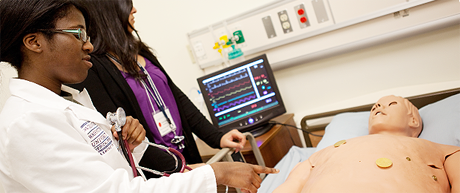Nursing education has come a long way over the years. GW’s student nurses now have hands on patient experiences in a 6,300-square-foot simulated hospital environment, long before they meet their first real patient. GW’s Skills and Simulation Laboratory, located at the Virginia Science & Technology Campus in Ashburn, Va., provides a premier and sophisticated learning environment. Students interact with lifelike manikins that simulate patients with a wide range of ages and illnesses. Video cameras record training simulations and allow nursing students to review their performances and learn in a real-life setting.
“We have been ranked in the top 10% of nursing schools nationwide, which has everything to do with the quality of our education, and the quality of our undergraduate education has everything to do with the Simulation Lab,” said Jean E. Johnson, dean of the School of Nursing and professor of nursing. “The lab is unique, because number one, just simply the size. It is really impressive what we have been able to do with the full support of the university. We also have state-of-the art monitoring equipment, high-fidelity manikins and faculty that fully embrace teaching in the Sim Lab.”
The lab’s innovative technology is designed and supported by GW’s Academic Technologies (AT) department. AT has been working on the challenge of creating more collaborative learning spaces since 2007. “Academic Technologies at GW has been critical to how effective our Simulation Lab is. They have guided us every step of the way in terms of selecting the equipment that we need, installing it, working with our faculty so we all know how to use it effectively,” said Johnson.
The design of the nursing lab, as well as several other planned spaces, won GW a national AMX Innovation Award for Best Collaborative Initiative in Higher Education. Presented at the UBTech 2012 conference, the award is given to institutions that transform education through innovative accomplishments and practices. It included a $25,000 grant for future technology investments at GW.
”The challenge of the space was trying to achieve all the faculty’s goals of being able to record and interact with students without the faculty physically being at the bedside with the students and without it seeming like the students are in a recording studio,” said John Arpino, assistant director of audiovisual design & engineering, GW’s Academic Technologies Department.
A faculty member monitors a student simulation exercise at a patient bed from the control room.
The Simulation Lab’s expansion during the summer of 2012 added 3,300 square feet to its existing lab in Innovation Hall. This additional facility, which opened for the fall 2012 cohort, added an eight-bed hospital ward, two private rooms and a studio apartment dedicated to in-home care.
The state-of-the art video capabilities allow for enhanced training and monitoring of students using the latest in video and voice capture. Two audiovisual control rooms were added where faculty control patient simulations in the virtual classroom setting. Cameras and microphones at each bed record student bedside interactions. Faculty and students can review the video recording synchronously or asynchronously. Faculty can now run simulations at more than one patient bed at a time, and have better control over audio and video capture options, resulting in more effective use of classroom time and enhanced student learning.
The high-level equipment selected by Academic Technologies for lab use includes 3 Echo 360 Recording Devices; 14 Sony EVIHD3 Cameras; AMX Enova Solution; 4 AMX MXT 1000 TP’s; 3 AMX TPI–Pro 2 DVI’s; 2 Biamp Audia Flex Frames.
The lab now boasts a total of 6,300-square-feet of lab space, twenty-one (21) mock hospital bed stations and exam areas, a home health studio apartment, and birthing and pediatrics simulation. The Lab is home to a variety of simulated (manikin) patients ranging in age from infant to adult, and displaying conditions from stagnant to high-fidelity. The twenty-one (21) manikins—who have names, personal histories, and lifelike features such as a pulse, voice, blinking eyes, and spurting blood—have physiologically accurate responses to the care provided by students.
“This is an amazing place to kind of get the jitters out and to learn different ways to do things, new ways to do things, and most of all, practice, practice, practice, so that we can get things right before you are face-to-face with a patient,” said Phillipa Morse, a GW School of Nursing student.
The expanded lab, complete with cutting-edge equipment, is unique enough to garner interest from the Virginia State Simulation Alliance (VASSA), which selected the GW School of Nursing to host their state-wide conference in late July. GW School of Nursing will engage nursing faculty from across Virginia in three days of workshops and seminars, and it is an honor for the University to host the conference.
With the additional simulation lab space, the School of Nursing was able to increase student enrollment by adding a second cohort each year, and matriculating the first spring cohort this year. Now, there are about 120 undergraduate nursing students at the GW VSTC campus. “GW is the place to be,” said Johnson.



